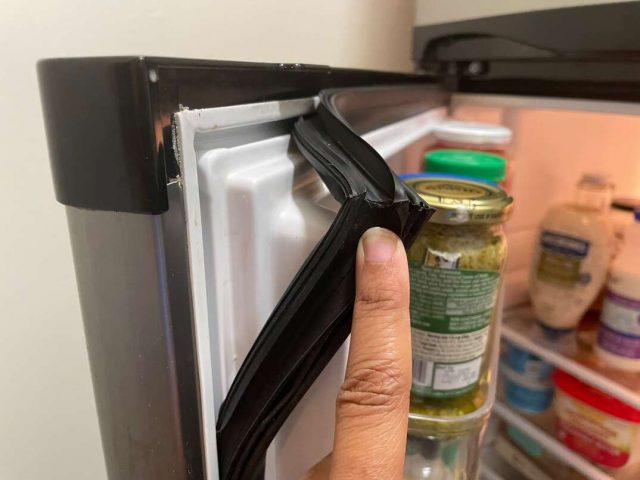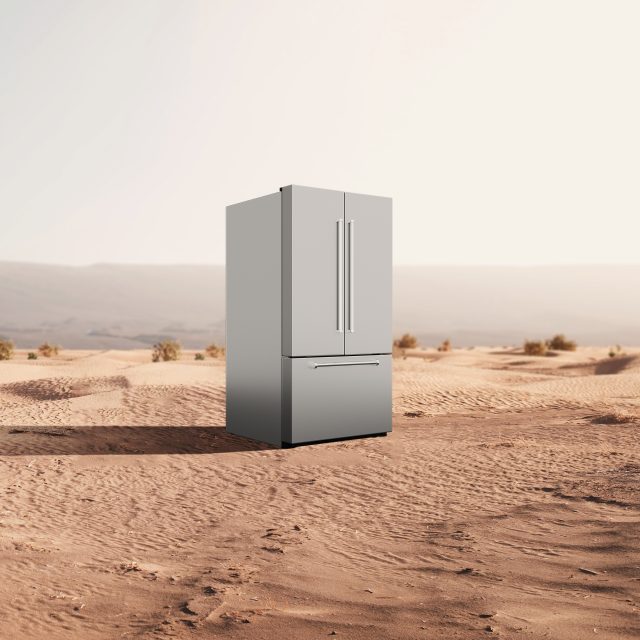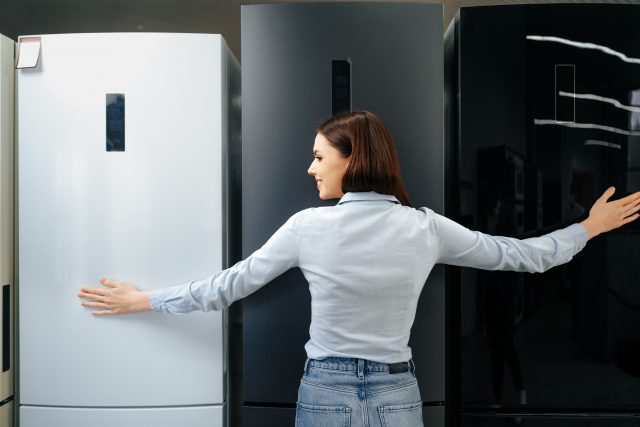Unlock the full potential of your fridge freezer with these top 10 hacks designed to maximise efficiency and ensure optimal performance. Start by regularly replacing worn-out door seals to maintain a tight grip, preventing the escape of cold air and infiltration of warmth. Shield your appliance from high heat sources through strategic placement, insulation, and protective measures, minimising energy consumption and preserving cooling efficiency. Boost overall efficiency by routinely cleaning condenser coils, preventing dirt buildup that could compromise the fridge freezer’s cooling capabilities. Before storing leftovers, pre-cool them to reduce the workload on the appliance, ensuring optimal freshness. Cultivate door discipline to minimise openings, preventing temperature fluctuations and optimising the overall cooling system. Safely remove plastic bags from the fridge and freezer, opting for eco-friendly alternatives. Regularly check and maintain optimal temperatures inside the appliance to ensure efficient cooling and food preservation. Set precise temperature controls, adjusting the fridge to 5 degrees Celsius and the freezer to -18 degrees Celsius for optimal balance and improved energy consumption. Promote appliance longevity by performing a full defrost every three months, preventing potential issues and maintaining efficiency. Lastly, maximise efficiency by filling your fridge with pre-chilled food and drinks, optimising cooling performance and reducing energy consumption. Adopt these 10 hacks to elevate your fridge freezer’s functionality and ensure a more sustainable and cost-effective kitchen experience.
So let’s jump right in.
1. Enhance Fridge Freezer Performance with Proper Door Seal Replacement
Elevate the efficiency and temperature control of your refrigerator by regularly replacing the door seal. The door seal plays a vital role in preserving energy and maintaining freshness. In this comprehensive guide, you’ll learn to recognize signs of wear, follow step-by-step replacement instructions, and understand the impact on your appliances’ longevity and energy efficiency. Ensure your refrigerator operates optimally by prioritising this essential maintenance task.
- Inspect the door seal for cracks or tears, noting any changes in flexibility.
- Have a screwdriver and a replacement seal that matches your refrigerator model ready.
- Unplug the refrigerator and remove items for easy access.
- Carefully peel off the old seal, unscrewing if necessary, and remember its position.
- Thoroughly clean any adhesive residue for a smooth attachment.
- Align and press the new seal firmly around the door perimeter.
- If needed, evenly secure screws according to manufacturer instructions.
- Restore power to the refrigerator for testing.
- Open and close the door to ensure a tight closure with no gaps or leaks.
- Schedule annual checks for continued efficiency and freshness preservation.

Door Seal Broken? Get a new one Now!
2. Tips to Shield your Fridge Freezer from High Heat Sources
Safeguard your refrigerator from potential damage caused by high heat sources. Excessive heat not only affects cooling efficiency but can also lead to premature wear and increased energy consumption. This article provides practical advice on strategic placement, insulation, and additional protective measures to shield your appliance from the adverse effects of elevated temperatures. By implementing these tips, you can ensure your fridge operates optimally even in warmer environments.
- Protect your refrigerator from potential damage caused by high heat sources.
- Excessive heat can impact cooling efficiency, leading to premature wear and increased energy consumption.
- Implement practical advice on strategic placement, insulation, and additional protective measures.
- Shield your appliance from the adverse effects of elevated temperatures for optimal operation.
- Ensure your fridge operates optimally, even in warmer environments, by following these protective measures.

3. A Comprehensive Guide to Cleaning Condenser Coils of Fridge Freezer
Understanding the pivotal role of clean condenser coils is essential for optimizing your refrigerator’s efficiency. These coils play a crucial part in dissipating heat, a fundamental function in ensuring the appliances’ optimal cooling performance. When these coils become laden with dirt and debris, their ability to regulate temperature is compromised, directly impacting the overall effectiveness of the refrigerator. Delve into this comprehensive guide to grasp the consequences of neglecting coil maintenance, revealing insights into the far-reaching effects on the appliance’s cooling capabilities.
Immerse yourself in the step-by-step cleaning process outlined in this guide, a vital procedure for restoring condenser coils to their optimal state. Beyond addressing immediate cooling concerns, this practice sets the stage for long-term benefits, maximizing both the efficiency and lifespan of your refrigerator. Regular coil cleaning is not merely a routine task; it emerges as a proactive strategy, a key investment in the sustained performance of your appliance. By incorporating this maintenance habit, you actively contribute to energy savings and the overall health of your refrigerator, ensuring it operates at peak efficiency over an extended period.
- Ensure safety by unplugging the refrigerator and moving it away from the wall to access the coils.
- Identify the condenser coils – typically located at the back or underneath the refrigerator.
- Gently use a soft brush or a vacuum cleaner with a nozzle attachment to remove loose debris and dust from the coils.
- Dampen a cloth or sponge with a mild cleaning solution and wipe down the coils to remove accumulated dirt and grime.
- For stubborn dirt, use a coil cleaning brush or a fin comb to reach between the coils for a more thorough cleaning.
- Inspect the condenser fan located near the coils. Ensure it is free of obstructions and spins freely for optimal performance.
- Use the vacuum cleaner or a handheld vacuum to pick up any remaining dirt and debris.
- Carefully move the refrigerator back into place, ensuring it is plugged back in.
- Plug the refrigerator back into the power source and allow it to resume normal operation.
- Schedule regular coil cleaning sessions, at least twice a year, to maintain efficiency and prolong the lifespan of your refrigerator.
4. Why and How to Cool Items Before Fridge Freezer Storage
Elevating your food storage practices involves understanding the significance of cooling items before placing them in the fridge freezer. This practice goes beyond mere convenience, offering both scientific and practical benefits. By lowering the initial temperature of perishables before freezing, you slow down the degradation process, preserving the texture, flavor, and nutritional value of your food over time. Additionally, pre-cooling strategically reduces the workload on your appliance. Placing warm items directly into the freezer can spike internal temperatures, requiring the fridge freezer to work harder. By adopting pre-cooling, you create a more efficient environment, optimizing the performance of your appliance while conserving energy. To seamlessly incorporate this habit, consider practical tips like letting hot dishes cool before refrigeration. , pre-cooling ensures the longevity and quality of the food stored in your fridge freezer, transforming your food storage routine into a more sustainable and efficient practice.
5. The Importance of Keeping Fridge Freezer Doors Closed
Keeping the doors of your fridge closed is really important. When you open the door too often, it messes with the temperature inside. Imagine it like this: every time you open the fridge, it’s like letting warm air in, and your fridge has to work extra hard to cool down again.
This guide is like a helpful manual that gives you practical tips on how to stop opening the fridge door too much. By following these tips, you’ll save energy, which is good for your wallet and the environment. It’s like turning off unnecessary lights to save electricity.
So, by getting into the habit of keeping the fridge doors closed, you not only save money on energy bills but also make sure your food stays fresh for a longer time. It’s a win-win!

6. Plastic-Free Fridges
Embrace a plastic-free approach to optimise your fridge storage. Safely remove plastic bags from the fridge and freezer, as they can pose safety concerns and harm the environment. This article educates readers on the potential hazards of using plastic in the fridge, offering eco-friendly alternatives for safer and more sustainable food storage. Discover the proper way to store items without compromising food safety, freshness, or environmental responsibility.
- Consider stainless steel containers as a durable and non-toxic alternative to plastic.
- Opt for reusable silicone storage bags for flexible and sustainable food storage.
- Use beeswax wraps for wrapping fruits, vegetables, and sandwiches – a washable and reusable option.
- Employ cloth bags made from natural materials for storing certain fruits and vegetables.
- Choose cardboard containers for items like eggs, which are biodegradable and recyclable.
- Utilise mesh produce bags made from cotton or natural fibres for breathable storage.
- Consider aluminium foil for covering and storing certain food items, as it is recyclable.
- Use paper bags for storing dry items like potatoes and onions, ensuring breathability.
- Select bamboo containers for lightweight, durable, and biodegradable storage solutions.
7. Temperature Mastery
Maintaining the right temperatures in your refrigerator is crucial for preserving the freshness and safety of your food. Ideally, your fridge should be set to around 5 degrees Celsius (or 37 degrees Fahrenheit), while the freezer should be set to -18 degrees Celsius (or 0 degrees Fahrenheit).
In this guide, we emphasise the significance of monitoring and managing these optimal temperatures. By keeping the fridge within this temperature range, you slow down bacterial growth, preventing food spoilage and ensuring a longer shelf life for perishables. The freezer’s sub-zero setting is essential for preserving frozen foods, maintaining their texture, flavor, and nutritional value.
We provide practical tips on using temperature checking tools, such as refrigerator thermometers, to verify that your appliance is operating within the recommended range. By mastering temperature control, you not only optimise your fridge’s performance but also contribute to a safer and more efficient food storage environment. This knowledge empowers you to create a healthy and well-preserved space for your groceries, minimising waste and maximising the quality of your stored items.
8. Why and How to Perform a Full Defrost Every 3 Months
Extend the life of your appliance with regular full defrosting. This article explores the benefits of defrosting, such as improved energy efficiency and prevention of potential issues. Gain insights into the step-by-step process of performing a full defrost every three months, ensuring your appliance operates at peak performance over time. Regular defrosting is a maintenance practice that contributes to the longevity and optimal functioning of your fridge freezer.
- Begin by unplugging your refrigerator to ensure safety during the defrosting process.
- Remove all food items from the freezer and transfer them to a cooler or another refrigeration source to keep them cold.
- Place towels at the base of the freezer to catch any water runoff during the defrosting.
- Leave the freezer door open to allow the ice to melt naturally. You can expedite this process by placing bowls of hot water inside the freezer.
- Use a plastic or wooden utensil to gently chip away at any remaining ice buildup, but avoid using sharp objects to prevent damage to the freezer’s interior.
- Wipe down the interior of the freezer with a clean, dry cloth once all the ice has melted and removed.
- If your freezer has a drainage tray, empty it and clean it thoroughly.
- Plug the refrigerator back in and wait for it to reach its optimal temperature before placing the food items back in the freezer.
- Regularly check and clean the freezers’ defrost drain to prevent clogs and ensure proper water drainage during future defrosting cycles.
- Make defrosting a routine every three months to maintain your appliance’s efficiency and prolong its lifespan, contributing to optimal functioning over time.
9. Maximising Fridge Efficiency with Pre-Chilled Foods
Boost the efficiency of your refrigerator by adopting the practice of strategically stocking it with pre-chilled food and drinks. This guide unfolds the advantages of pre-chilling and provides actionable tips for seamlessly incorporating this habit into your routine. Dive into the details of how this straightforward practice can elevate the overall cooling performance of your fridge, optimise energy consumption, and guarantee the extended freshness of stored items.
By introducing pre-chilled items into your fridge, you actively contribute to sustaining optimal temperatures within the appliance. This not only enhances the effectiveness of the cooling system but also plays a key role in preserving the quality of your stored food and beverages. The benefits extend beyond mere convenience, creating a more energy-efficient and eco-conscious approach to managing your refrigerator. This simple yet impactful habit is a proactive step towards maintaining a well-functioning and sustainable kitchen environment.
10. Balanced Cooling Temperatures
Setting the right temperatures for your fridge and freezer is like finding the sweet spot to keep your food fresh and your energy bills in check. For your fridge, aim for around 5 degrees Celsius (or 37 degrees Fahrenheit). It’s like creating a cool but not too cold environment where your veggies stay crisp, and your dairy and meats stay safely chilled.
Now, for the freezer, aim for -18 degrees Celsius (or 0 degrees Fahrenheit). Picture it like a winter wonderland in there, keeping your ice cream solid and your frozen goods perfectly preserved.
This guide breaks down these recommended temperature settings, making it clear how they impact the quality of your food and the efficiency of your appliances. Think of it as finding the Goldilocks setting – not too warm, not too cold – just right for keeping everything fresh and your energy usage efficient.
By understanding and setting these temperatures just right, you’re not only ensuring your food stays at its best, but you’re also giving your fridge and freezer the optimal conditions to do their job effectively and last a long time. It’s like giving your appliances the VIP treatment they deserve. So, take a moment to set those temperatures with precision – it’s a small step that makes a big difference in keeping your kitchen running smoothly.
Setting the right temperatures for your fridge and freezer is like finding the sweet spot for fresh food and energy efficiency. Aim for around 5 degrees Celsius in the fridge for crisp veggies and safely chilled dairy and meats. In the freezer, target -18 degrees Celsius for a winter wonderland that keeps ice cream solid and frozen goods perfectly preserved. This guide ensures you hit the Goldilocks setting, not too warm, not too cold, maximizing food quality and appliance efficiency. Service Engineer- ADK Kooling
Spotted signs your fridge is making some trouble? It’s probably time to call in the experts.
All sorts of little things can go wrong with fridge freezers. Some are very minor and can be fixed with a screwdriver or a quick clean. But others may require a specialist diagnosis and repairs.
But be warned: it could get you into trouble if you attempt to make the repairs yourself without the right training or know-how. It isn’t advisable, and it might put off some repairmen and women from wanting to work on them if the problem isn’t resolved.
If you’re living in London or the South-East of England and your fridge is showing one or more of these telltale signs of dying — then I’d like to suggest you give one of our specialists a call.
Some reasons to consider us include:
- Our engineers can get out to you in just a few hours.
- Our call-outs are set at fixed prices — with no sneaky hidden extra charges.
- We carry lots of spare and replacement parts, so it’s extremely unlikely you’ll have to wait round for us to order one.
- We can guarantee a 90-day warranty on all our repairs
Find out more about our domestic fridge freezer repairs & get an engineer out ASAP.






